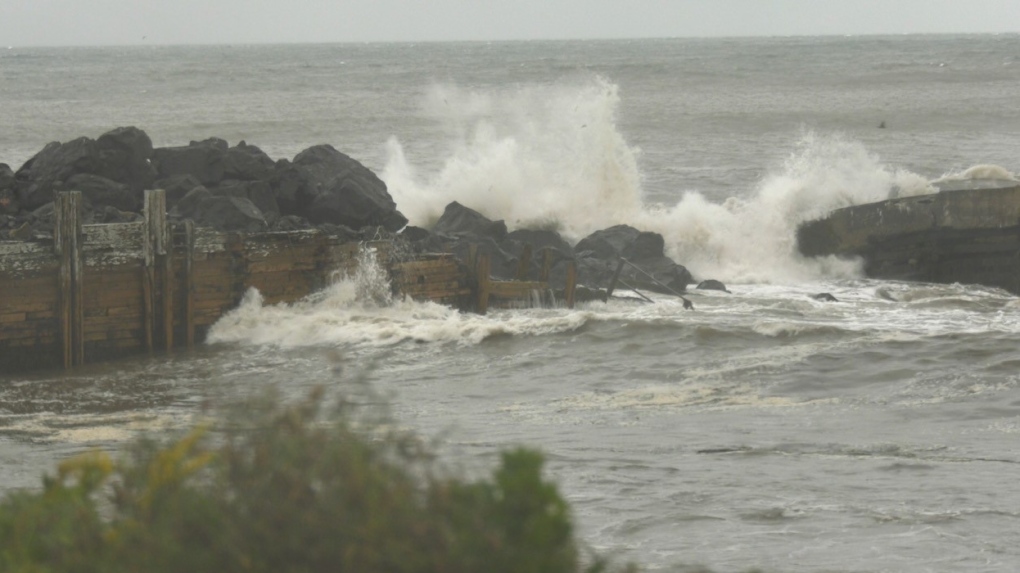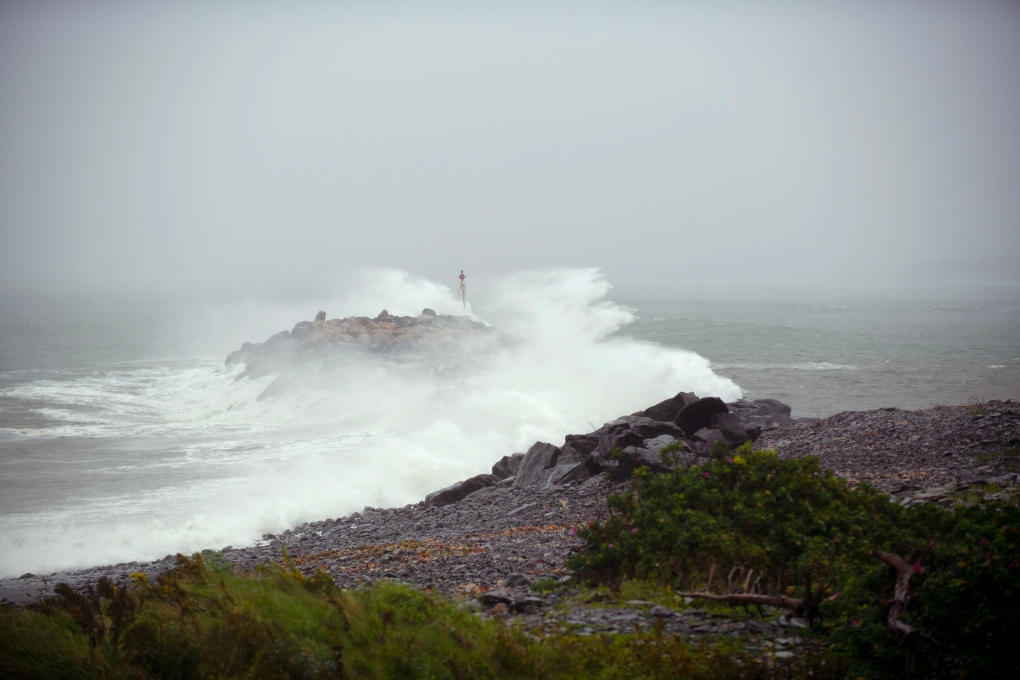Post-tropical storm Lee hits the Maritimes with flooding, high waves and power outages
Post-tropical storm Lee has hit the Maritimes, bringing with it flooding, high waves and power outages affecting tens of thousands of homes Saturday.
The centre of post-tropical storm Lee made landfall at 5 p.m. Saturday on Long Island — an island in Digby County on the western coast of Nova Scotia. Areas of coastal Nova Scotia are experiencing significant storm surges, with waves crashing into roadways.
In the neighbouring Municipality of the District of Barrington, warden Eddie Nickerson said major waves have pummeled beaches, with ocean water covering coastal roads.
“The beach, it was quite a ball of waves there, bringing the stones over the road. It blocked a road off down there, and a pole was on fire on Stoney Island,” Nickerson said, referring to a community on Cape Sable Island.
Nickerson said Lee’s damage appears to have been less intense than anticipated, which is a relief to the region that was hard hit by wildfires earlier this summer.
In the sea-side community of St. Andrews, N.B., mayor Brad Henderson said it will require a lot of work to deal with the many large trees that have been downed by Lee.
“We’ve had a lot of trees that have been knocked down in our community, a lot of those have gone across roads and across power lines,” Henderson said in an interview Saturday.
That’s what happened to a power line out front of St. Andrews resident Allan Flewelling’s home. He said he heard a snap, and saw that a large tree from his lawn had toppled -- causing a small fire.
“We noticed the tree had fallen on the wires, caught fire. Then the mayor actually drove by shortly after that, and he called it in,” Flewelling said.
In Grand Manan, N.B., ferry service has been suspended between the island and mainland New Brunswick.
Grand Manan Mayor Bonnie Morse said in an interview Saturday Lee has hit the island with high winds and has felt “a lot like a good nor’easter storm.”
“But we seem to have survived everything okay so far,” Morse said around 4:30 p.m.
The mayor extended a thanks to Department of Transportation and Infrastructure crews, linesmen and NB Power crews for their ongoing work on the island.
“We’ve had a lot of trees down and roads blocked... But they seem to be keeping up reasonably well -- and given the weather conditions, that's saying a lot.
Yarmouth Mayor Pam Mood said in an interview around noon Saturday that the area is “not getting as hard a hit as we originally anticipated.”
“Lots of wind here -- there are some trees down, but far better than we thought,” she said.
IN PICTURES: Lee brings heavy winds to the Maritimes
As of about 10 p.m., there were more than 117,500 houses without power in Nova Scotia, about 18,500 customers in the dark in New Brunswick, and about 1,900 homes with no power on P.E.I.
No outages were reported by Newfoundland Power as of 7:45 p.m.
Matt Drover with Nova Scotia Power said in an interview Saturday crews are mobilized and working on restoring power in areas where winds are below 80 kilometres an hour.
“We’ve been preparing all week for this storm, we knew that Lee was going to be a significant storm with really high winds,” Drover said.
“Yesterday all of our crews from out of Nova Scotia arrived, we put them pretty much everywhere in the province -- recognizing that the western part of the province, the South Shore, the Valley, and also HRM would likely be hit the hardest.”
Erica Fleck, Halifax Regional Municipality’s emergency management director, is asking all residents to stay indoors and keep away from the coastline until the storm clears.
“It is really unsafe for people to be out there right now, we’re really urging residents to please be smart and stay home and shelter in place. There’s no need to be out right now unless it’s an absolute emergency,” Fleck said in an interview Saturday.
Fleck said that some roadways in the Lawrencetown area and the Eastern Shore have been “wiped out” by storm surges.
 Waves crashing into a coastline in Digby, N.S., on Sept. 16, 2023, during post-tropical storm Lee. (CTV Atlantic/Sarah Plowman)
Waves crashing into a coastline in Digby, N.S., on Sept. 16, 2023, during post-tropical storm Lee. (CTV Atlantic/Sarah Plowman)
The storm was downgraded from a hurricane before it hit the region. The designation refers to the structure of the storm and does not indicate lessened impacts.
“Water has already crossed roads… Roads that were fixed during the fires and the floods between May and July are out again in the Peggys Cove area,” Fleck said.
“There are issues in Herring Cove, issues in Bedford, basically anywhere near water we’re already seeing issues, and the peak hasn’t come yet,” Fleck said around 12:30 p.m.
Nova Scotia RCMP are asking drivers to stay off the roads. Police said they've been receiving reports of drivers heading to the coast to watch the waves.
"This action is putting themselves at risk along with First Responders in the event of rescue attempts," said RCMP in a post on social media.
 Waves crash against a breakwater in Port Maitland, N.S. as post-tropical cyclone Lee approaches on Saturday, Sept. 16, 2023. THE CANADIAN PRESS/Bill Curry
Waves crash against a breakwater in Port Maitland, N.S. as post-tropical cyclone Lee approaches on Saturday, Sept. 16, 2023. THE CANADIAN PRESS/Bill Curry
Environment Canada said that areas along Nova Scotia's central Atlantic coast could see breaking waves of between four and six metres, and storm surge warnings were in effect from Shelburne County eastward to Guysborough County.
In New Brunswick there are reports of flooding in some low-lying areas, including in Saint John and in Fredericton.
A couple historic trees believed to be more than 100 years old have been downed in uptown Saint John. City officials said in a statement that crews and arborists are addressing the sites on a priority basis and the public is asked to avoid driving around fallen trees and to use extreme caution in areas where crews are working.
Early Saturday a hurricane watch was in place for Grand Manan Island and coastal Charlotte County, N.B., and for most of Nova Scotia's Atlantic coast, stretching from Digby County through to Halifax County. A tropical storm warning also covered most of Nova Scotia and for New Brunswick's Bay of Fundy coast and parts of the province along the Northumberland Strait.
As of Saturday evening, the highest recorded wind gust by Environment Canada weather stations was 117 kilometres an hour, which was recorded at the Halifax Stanfield International Airport.
The storm was forecast to bring more than 100 millimetres of rain in some areas, and Environment Canada is warning of possible flooding in parts of southwestern Nova Scotia and New Brunswick, including Saint John and Moncton.
 In Saint John N.B.'s Kings Square, a large tree has been knocked down as post-tropical storm Lee heads towards the region. Pictured Sept. 16, 2023. (CTV Atlantic/Avery MacRae).
In Saint John N.B.'s Kings Square, a large tree has been knocked down as post-tropical storm Lee heads towards the region. Pictured Sept. 16, 2023. (CTV Atlantic/Avery MacRae).
“Though Lee has transitioned from a hurricane to a strong post-tropical cyclone, our concerns about the threat it poses are unchanged,” said Kyle Leavitt, New Brunswick's Emergency Measures Organization director, in a Saturday afternoon statement. “In fact, Lee has arrived faster and with slightly greater intensity than expected.”
On P.E.I., Public Safety Minister Bloyce Thompson is asking Islanders to “make final preparations” for the storm that is expected to hit the province later on Saturday.
“We know that this will not be as strong as storms that have impacted us over the previous few years, but we need to be sensible in preparing so that we are ready in any event. I urge Islanders to please stay inside during times of high winds, stay inland and away from coastal water,” Thompson said in a statement Saturday.
With files from The Canadian Press.
Click here for a photo gallery of the impact of post-tropical storm Lee in the Maritime provinces.
CTVNews.ca Top Stories

W5 Investigates A 'ticking time bomb': Inside Syria's toughest prison holding accused high-ranking ISIS members
In the last of a three-part investigation, W5's Avery Haines was given rare access to a Syrian prison, where thousands of accused high-ranking ISIS members are being held.
'Mayday!': New details emerge after Boeing plane makes emergency landing at Mirabel airport
New details suggest that there were communication issues between the pilots of a charter flight and the control tower at Montreal's Mirabel airport when a Boeing 737 made an emergency landing on Wednesday.
Federal government posts $13B deficit in first half of the fiscal year
The Finance Department says the federal deficit was $13 billion between April and September.
Canadian news publishers suing ChatGPT developer OpenAI
A coalition of Canadian news publishers is suing OpenAI for using news content to train its ChatGPT generative artificial intelligence system.
Weather warnings for snow, wind issued in several parts of Canada
Winter is less than a month away, but parts of Canada are already projected to see winter-like weather.
BREAKING Supreme Court affirms constitutionality of B.C. law on opioid health costs recovery
Canada's top court has affirmed the constitutionality of a law that would allow British Columbia to pursue a class-action lawsuit against opioid providers on behalf of other provinces, the territories and the federal government.
Cucumbers sold in Ontario, other provinces recalled over possible salmonella contamination
A U.S. company is recalling cucumbers sold in Ontario and other Canadian provinces due to possible salmonella contamination.
Nick Cannon says he's seeking help for narcissistic personality disorder
Nick Cannon has spoken out about his recent diagnosis of narcissistic personality disorder, saying 'I need help.'
Real GDP per capita declines for 6th consecutive quarter, household savings rise
Statistics Canada says the economy grew at an annualized pace of one per cent during the third quarter, in line with economists' expectations.


































